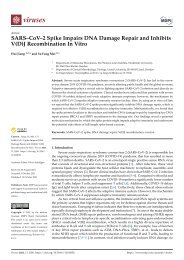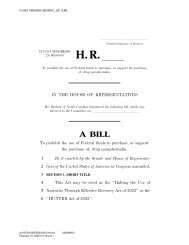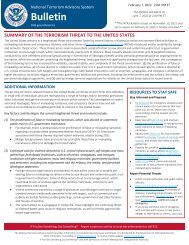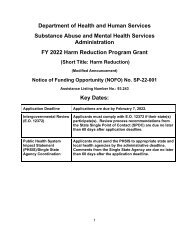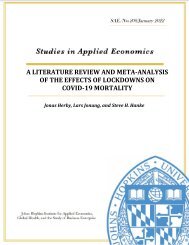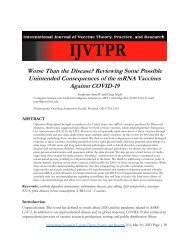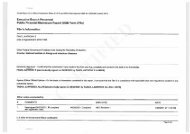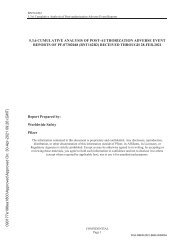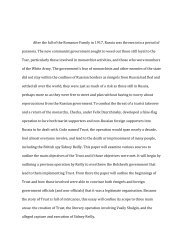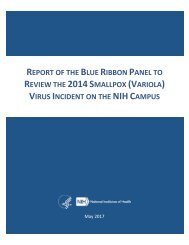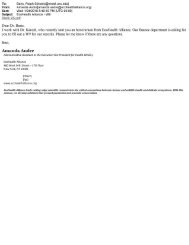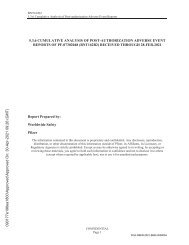MSH3 Homology and Potential Recombination Link to SARS-CoV-2 Furin Cleavage Site
Create successful ePaper yourself
Turn your PDF publications into a flip-book with our unique Google optimized e-Paper software.
Ambati et al.<br />
<strong>MSH3</strong> <strong>and</strong> <strong>SARS</strong>-<strong>CoV</strong>-2 Spike <strong>Homology</strong><br />
FIGURE 1 | The origin of the furin sequence in <strong>SARS</strong>-<strong>CoV</strong>-2. Comparison of the protein sequences at the S1/S2 junction in <strong>SARS</strong>-<strong>CoV</strong>, RaTG13, <strong>and</strong> <strong>SARS</strong>-<strong>CoV</strong>-2<br />
demonstrating the presence of the furin cleavage site (FCS) PRRA only in <strong>SARS</strong>-<strong>CoV</strong>-2. Based on a BLAST search of the 12-nucleotide stretch coding for the FCS<br />
PRRA, a 19-nucleotide long identical sequence was identified in the patented (US 958 7003) sequence Seq ID11652. SEQ ID11652 is transcribed <strong>to</strong> a <strong>MSH3</strong> mRNA<br />
that appears <strong>to</strong> be codon optimized for humans. This 19-nucleotide sequence including 12 nucleotides coding for the FCS PRRA, present in the human <strong>MSH3</strong> gene<br />
might have been introduced in<strong>to</strong> the <strong>SARS</strong>-<strong>CoV</strong>-2 genome by the illustrated copy choice recombination mechanism in <strong>SARS</strong>-<strong>CoV</strong>-2 infected human cells<br />
overexpressing the <strong>MSH3</strong> gene.<br />
<strong>SARS</strong>-COV-2 SPIKE PROTEIN AND <strong>MSH3</strong><br />
A peculiar feature of the nucleotide sequence encoding the<br />
PRRA furin cleavage site in the <strong>SARS</strong>-<strong>CoV</strong>-2S protein is its<br />
two consecutive CGG codons. This arginine codon is rare in<br />
coronaviruses:relativesynonymouscodonusage(RSCU)ofCGG<br />
in pangolin <strong>CoV</strong> is 0, in bat <strong>CoV</strong> 0.08, in <strong>SARS</strong>-<strong>CoV</strong> 0.19, in<br />
MERS-<strong>CoV</strong>0.25,<strong>and</strong>in<strong>SARS</strong>-<strong>CoV</strong>-20.299(9).<br />
A BLAST search for the 12-nucleotide insertion led us <strong>to</strong> a<br />
100% reverse match in a proprietary sequence (SEQ ID11652,<br />
nt 2751-2733) found in the US patent 9,587,003 filed on Feb.<br />
4, 2016 (10) (Figure1). Examination of SEQ ID11652 revealed<br />
that the match extends beyond the 12-nucleotide insertion <strong>to</strong><br />
a 19-nucleotide sequence: 5 ′ -CTACGTGCCCGCCGAGGAG-<br />
3 ′ (nt 2733-2751 of SEQ ID11652), such that the resulting<br />
mRNA would have 3 ′ - GAUGCACGGGCGGCUCCUC-5 ′ , or<br />
equivalently 5 ′ - CU CCU CGG CGG GCA CGU AG-3 ′<br />
(nucleotides 23547-23565 in the <strong>SARS</strong>-<strong>CoV</strong>-2 genome, in which<br />
the four bold codons yield PRRA, amino acids 681–684 of its<br />
spikeprotein).ThisisveryrareintheNCBIBLASTdatabase.<br />
The correlation between this <strong>SARS</strong>-<strong>CoV</strong>-2 sequence <strong>and</strong><br />
the reverse complement of a proprietary mRNA sequence<br />
is of uncertain origin. Conventional biostatistical analysis<br />
indicates that the probability of this sequence r<strong>and</strong>omly being<br />
Frontiers in Virology | www.frontiersin.org 2 February 2022 | Volume 2 | Article 834808




